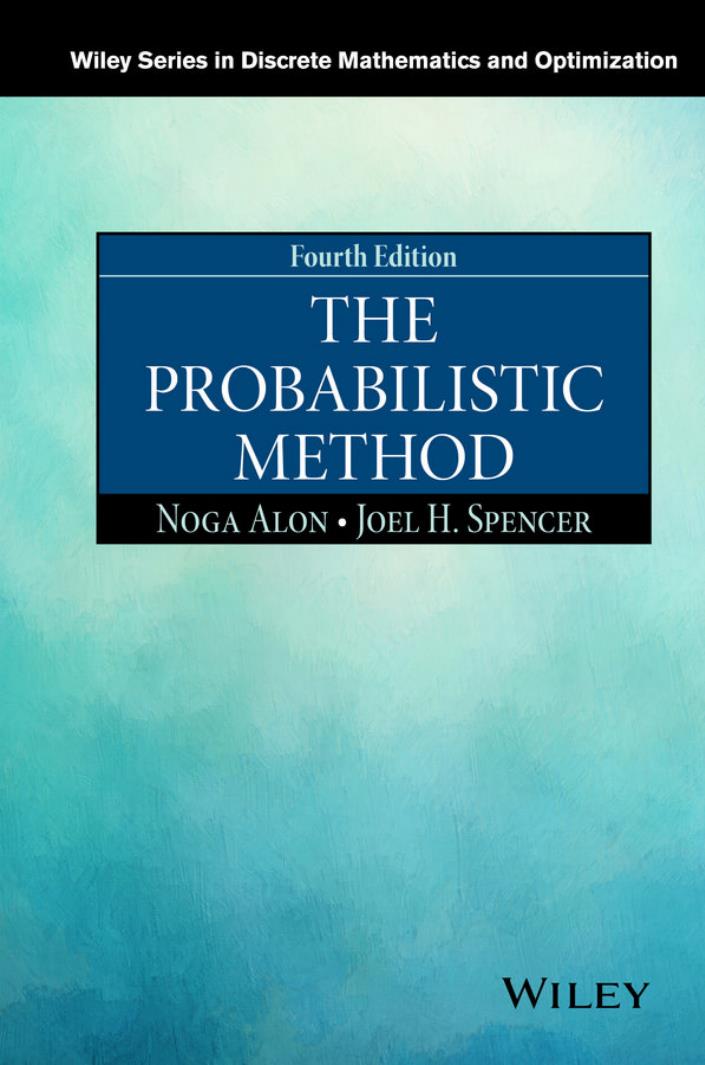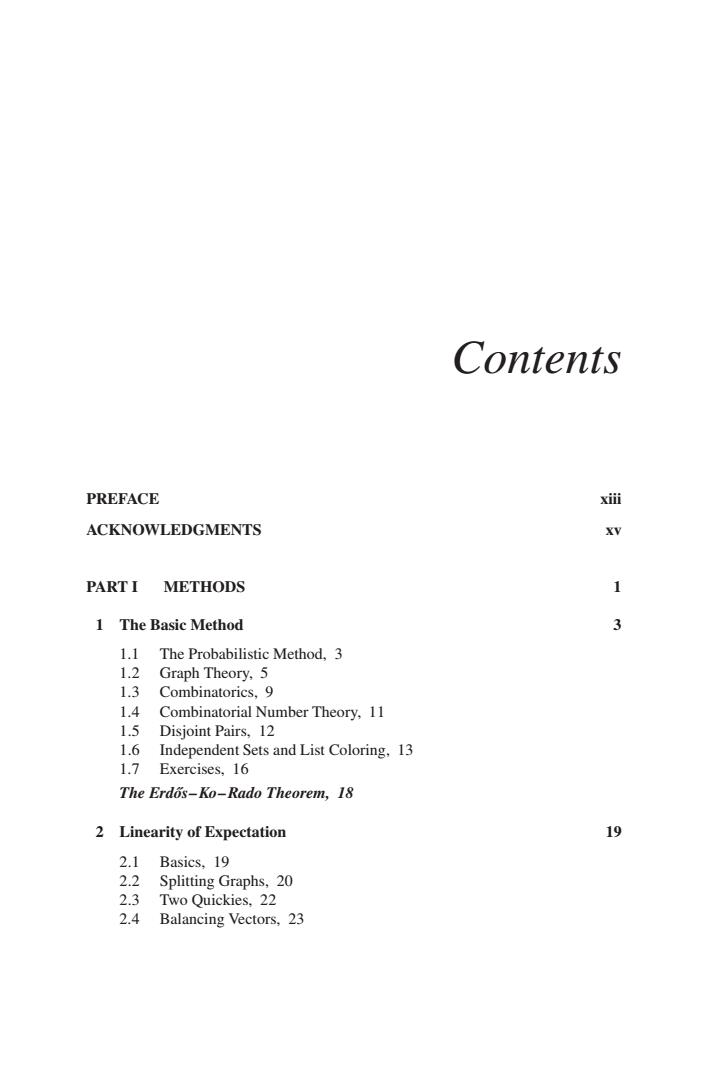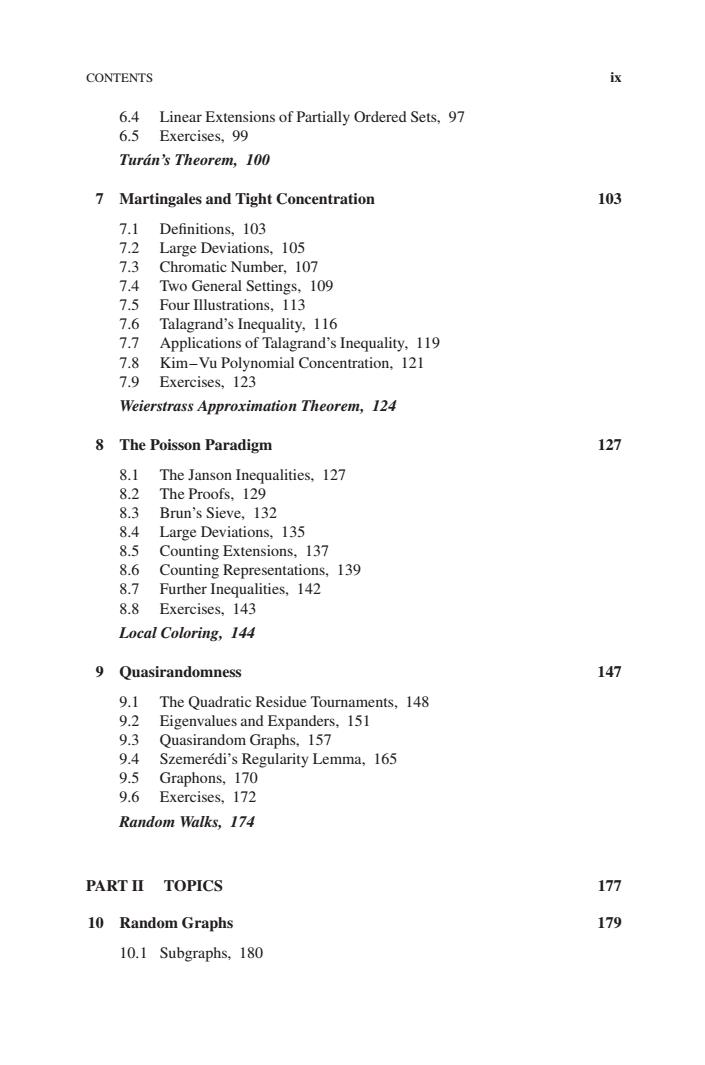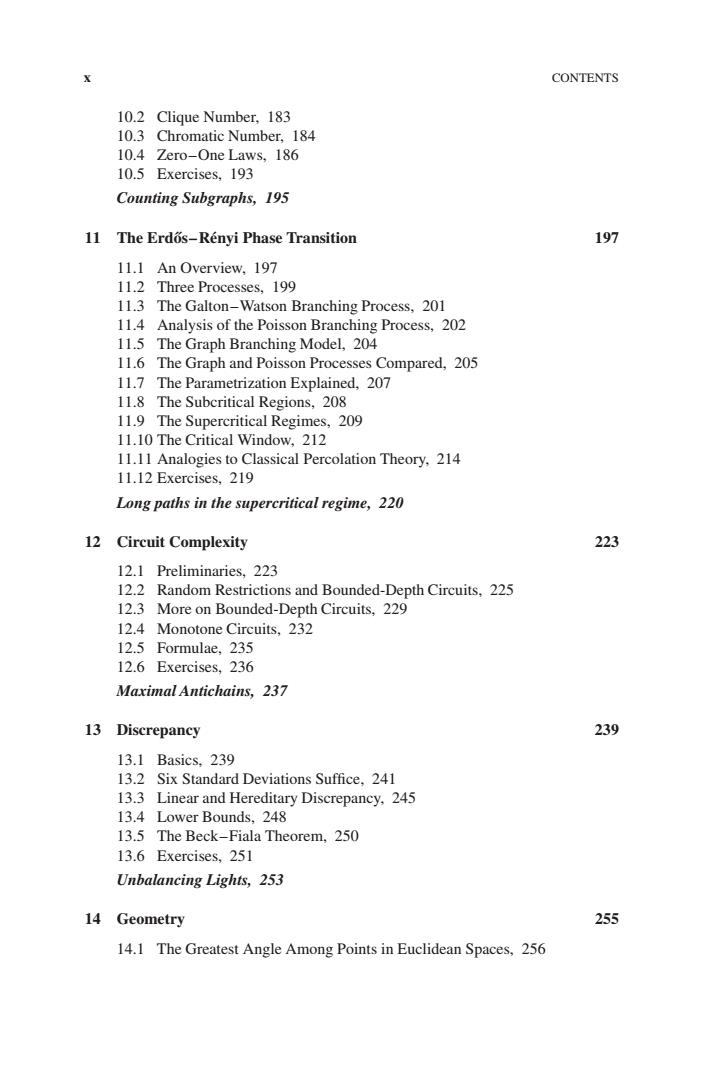
Wiley Series in Discrete Mathematics and Optimization Fourth Edition THE PROBABILISTIC METHOD NOGA ALON JOEL H.SPENCER WILEY

Contents PREFACE xi ACKNOWLEDGMENTS PARTI METHODS 1 The Basic Method 1.1 The Probabilistic Method,3 Graph Theory.5 Combinatorics,9 1.4 Combinatorial Number Theory,11 1.5 Disjoint Pairs,12 1.6 Independent Sets and List Coloring.13 1.7 Exercises,16 The Erdos-Ko-Rado Theorem,18 2 Linearity of Expectation 19 o
Contents PREFACE xiii ACKNOWLEDGMENTS xv PART I METHODS 1 1 The Basic Method 3 1.1 The Probabilistic Method, 3 1.2 Graph Theory, 5 1.3 Combinatorics, 9 1.4 Combinatorial Number Theory, 11 1.5 Disjoint Pairs, 12 1.6 Independent Sets and List Coloring, 13 1.7 Exercises, 16 The Erd ˝os–Ko–Rado Theorem, 18 2 Linearity of Expectation 19 2.1 Basics, 19 2.2 Splitting Graphs, 20 2.3 Two Quickies, 22 2.4 Balancing Vectors, 23

i进 CONTENTS 2.5 Unbalancing Lights.25 2.6 Without Coin Flips,26 2.7 Exercises.27 Brigman's Theorem,29 3 Alterations 31 3.1 Ramsey Numbers,31 ndent Sets,33 33 ial Geometry,34 5 Packing. Greedy Coloring.36 6 Continuous Time,38 3.7 Exercises.41 High Girth and High Chromatic Number,43 4 The Second Moment 45 4.1 Basics,45 40 Number Theory,46 43 More Basics .49 44 Random Grap 4.5 que Numb Dis 57 The Rodl nib ble,58 4.8 Exercises,64 Hamiltonian Paths,65 5 The Local Lemma 5.1 The lemma 69 5.2 Property B and Multicolored Sets of Real Numbers,72 5.3 Bou nds for Ran 54 The Linear Arb 5.6 of Graphs.76 atin Iransversals,8 5.7 Moser's Fix-It Algorithm,81 5.8 Exercises.87 Directed Cycles,88 6 Correlation Inequalities 89 6.1 The Four Functions Theorem of Ahlswede and Daykin,90 6.2 The FKG Inequality,93 6.3 Monotone Properties,94
viii CONTENTS 2.5 Unbalancing Lights, 25 2.6 Without Coin Flips, 26 2.7 Exercises, 27 Brégman’s Theorem, 29 3 Alterations 31 3.1 Ramsey Numbers, 31 3.2 Independent Sets, 33 3.3 Combinatorial Geometry, 34 3.4 Packing, 35 3.5 Greedy Coloring, 36 3.6 Continuous Time, 38 3.7 Exercises, 41 High Girth and High Chromatic Number, 43 4 The Second Moment 45 4.1 Basics, 45 4.2 Number Theory, 46 4.3 More Basics, 49 4.4 Random Graphs, 51 4.5 Clique Number, 55 4.6 Distinct Sums, 57 4.7 The Rödl nibble, 58 4.8 Exercises, 64 Hamiltonian Paths, 65 5 The Local Lemma 69 5.1 The Lemma, 69 5.2 Property B and Multicolored Sets of Real Numbers, 72 5.3 Lower Bounds for Ramsey Numbers, 73 5.4 A Geometric Result, 75 5.5 The Linear Arboricity of Graphs, 76 5.6 Latin Transversals, 80 5.7 Moser’s Fix-It Algorithm, 81 5.8 Exercises, 87 Directed Cycles, 88 6 Correlation Inequalities 89 6.1 The Four Functions Theorem of Ahlswede and Daykin, 90 6.2 The FKG Inequality, 93 6.3 Monotone Properties, 94

CONTENTS 6.4 Linear Extensions of Partially Ordered Sets,97 6.5 Exercises,99 Turan's Theorem,100 7 Martingales and Tight Concentration 103 7.1 Definitions,103 7.2 Large Deviations,105 7.3 Chromatic Number,107 7.4 Two General Settings,109 75 Four Illustrations,113 7.6 Talagrand's Inequality,116 7.7 Applications of Talas Kim-VuPo Exercises,123 Weierstrass Approximation Theorem,124 8 The Poisson Paradigm 127 8.1 The Janson Inequalities,127 8.2 The Proofs,129 8.3 Brun's Sieve 132 84 Large Deviations,135 只5 Counting Extensions,137 86 Counting 87 Further 142 8.8 Exercises,143 Local Coloring,144 147 9.1 The Quadratic Residue Tournaments,148 9.2 Eigenvalues and Expanders,151 9.3 Quasirandom Graphs,157 94 Szemeredi's Regularity Lemma.165 9.5 Graphons,170 9.6 Exercises,172 Random Walks,174 PARTⅡTOPICS 177 10 Random Graphs 179 10.1 Subgraphs,180
CONTENTS ix 6.4 Linear Extensions of Partially Ordered Sets, 97 6.5 Exercises, 99 Turán’s Theorem, 100 7 Martingales and Tight Concentration 103 7.1 Definitions, 103 7.2 Large Deviations, 105 7.3 Chromatic Number, 107 7.4 Two General Settings, 109 7.5 Four Illustrations, 113 7.6 Talagrand’s Inequality, 116 7.7 Applications of Talagrand’s Inequality, 119 7.8 Kim–Vu Polynomial Concentration, 121 7.9 Exercises, 123 Weierstrass Approximation Theorem, 124 8 The Poisson Paradigm 127 8.1 The Janson Inequalities, 127 8.2 The Proofs, 129 8.3 Brun’s Sieve, 132 8.4 Large Deviations, 135 8.5 Counting Extensions, 137 8.6 Counting Representations, 139 8.7 Further Inequalities, 142 8.8 Exercises, 143 Local Coloring, 144 9 Quasirandomness 147 9.1 The Quadratic Residue Tournaments, 148 9.2 Eigenvalues and Expanders, 151 9.3 Quasirandom Graphs, 157 9.4 Szemerédi’s Regularity Lemma, 165 9.5 Graphons, 170 9.6 Exercises, 172 Random Walks, 174 PART II TOPICS 177 10 Random Graphs 179 10.1 Subgraphs, 180

CONTENTS 10.2 Clique Number,183 10.3 Chromatic Number.184 10.4 Zero-One Laws,186 105 Exercises 193 Counting Subgraphs,195 11 The Erdos-Renyi Phase Transition 197 11.1 An Overview.197 11.2 c 3 9 -Watson Branching Process,201 11. Analysis of the Poisson Branching Process.202 11.5 The Graph Branching Model,204 11.6 The Graph and Poisson Processes Compared,205 11.7 The Parametrization Explained.207 118 The Subcritical Regions.208 11.9 The Supercritical Regimes,209 11.10 The Cri ical winde 212 11.12 Exercises,219 Long paths in the supercritical regime,220 12 Circuit Complexity 223 12.1 Preliminaries,223 12.2 Random Restrictions and Bounded-Depth Circuits,225 12.3 More on Bounded-Depth Circuits,229 12.4 Monotone Circuits.232 12.5 Formulae.235 12.6 Exercises,236 Maximal Antichains,237 13 Discrepancy 239 13.1 Basics,239 13. 2 Six Standard Deviations Suffice,241 13. 3 Linear and Hereditary Discrepancy,245 13.4 Lower Bounds.248 13.5 The Beck-Fiala Theorem,250 13.6 Exercises,251 Unbalaneing Lights,253 14 Geometry 255 14.1 The Greatest Angle Among Points in Euclidean Spaces,256
x CONTENTS 10.2 Clique Number, 183 10.3 Chromatic Number, 184 10.4 Zero–One Laws, 186 10.5 Exercises, 193 Counting Subgraphs, 195 11 The Erdos–Rényi Phase Transition 197 ˝ 11.1 An Overview, 197 11.2 Three Processes, 199 11.3 The Galton–Watson Branching Process, 201 11.4 Analysis of the Poisson Branching Process, 202 11.5 The Graph Branching Model, 204 11.6 The Graph and Poisson Processes Compared, 205 11.7 The Parametrization Explained, 207 11.8 The Subcritical Regions, 208 11.9 The Supercritical Regimes, 209 11.10 The Critical Window, 212 11.11 Analogies to Classical Percolation Theory, 214 11.12 Exercises, 219 Long paths in the supercritical regime, 220 12 Circuit Complexity 223 12.1 Preliminaries, 223 12.2 Random Restrictions and Bounded-Depth Circuits, 225 12.3 More on Bounded-Depth Circuits, 229 12.4 Monotone Circuits, 232 12.5 Formulae, 235 12.6 Exercises, 236 Maximal Antichains, 237 13 Discrepancy 239 13.1 Basics, 239 13.2 Six Standard Deviations Suffice, 241 13.3 Linear and Hereditary Discrepancy, 245 13.4 Lower Bounds, 248 13.5 The Beck–Fiala Theorem, 250 13.6 Exercises, 251 Unbalancing Lights, 253 14 Geometry 255 14.1 The Greatest Angle Among Points in Euclidean Spaces, 256